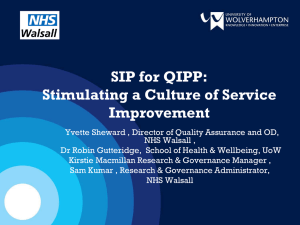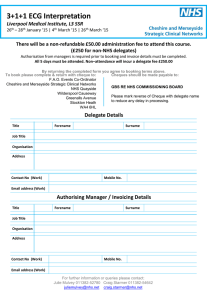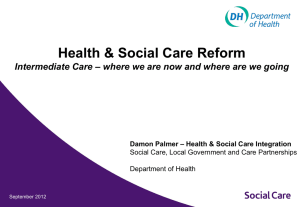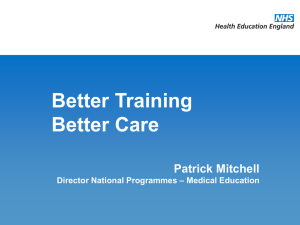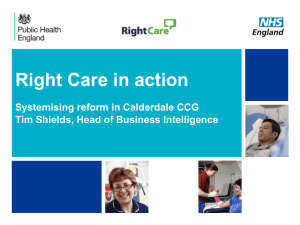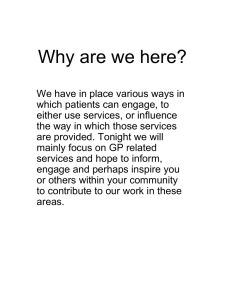Introducing the NHS Change Model
advertisement
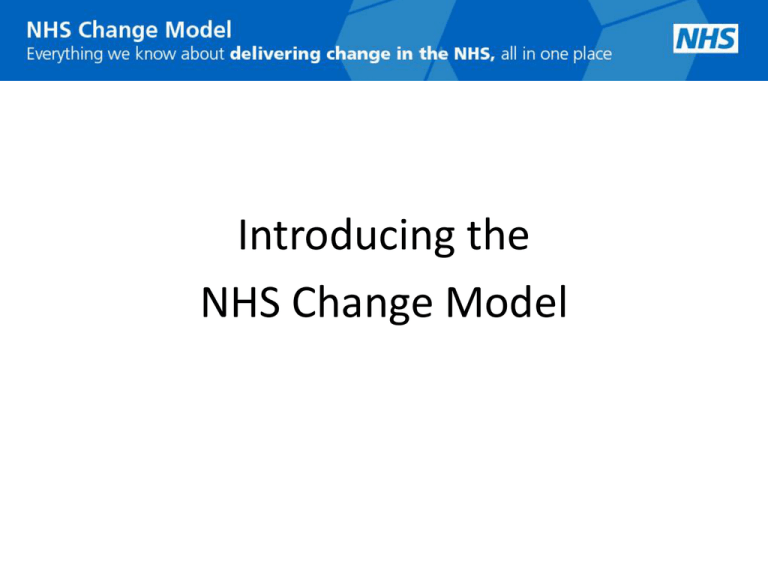
Introducing the NHS Change Model Why the NHS needs a Change Model • Massive change in the NHS over past 10 years – much more to come • Massive change now required to deliver wholesale improvement and quality of services – scale and pace • Financial constraints for the foreseeable future • Using the best of what’s gone before • Building on our knowledge of large scale change • Amplifying and reinforcing our ability to drive change • Fit for new system work – across boundaries and sectors • The call to action The overall aim Supporting the NHS commissioning system to adopt a shared approach to leading change and transformation in order to: – maximise the potential to deliver unprecedented improvement across the whole system – enable the NHS to deliver QIPP at scale and pace – create a common language of change across the NHS – provide a useful tool for people to structure local work around – allow better integration of change efforts – build a coherent approach to learning and development – build on the best evidence and support rapid spread of replicable innovation – establish a core operating model for NHS Commissioning Board How we developed the NHS Change Model • Looking at best practice from across the world • Learning from what’s gone before to create a common approach • Consulting with people in the service – using their ideas, experiences and words – c500 people • Building on all we’ve learned about large scale change • Sharing progress – descriptors and design • Making sense at every level • Bringing together all 8 components into one place with a distinctive appearance NHS Change Model www.changemodel.nhs.uk How to use the NHS Change Model • The 8 component parts and what they mean • The sum of all the parts is greater than the parts individually • Build on what you already do and know – exploit existing assets and resources – proven techniques, models and approaches • Change and improvement tools Our shared purpose • Patients and their experience of the NHS and their health care are at the heart of what we do and drives change • The NHS Change Model is for everyone • Connects people and links our values • Helps us understand each other’s roles • Making change happen together • Individuals, teams, organisations, communities and the NHS • Fundamentally underpinned by the NHS Constitution Engagement to mobilise – are we engaging and mobilising the right people? • Who needs to be involved? • Understanding, recognising and valuing individuals’ contributions • Engaging people as well as mobilising • Getting the message right – from Board to Ward and able to cross boundaries • Using engaging stories on progress and improvements made • Catching the zeitgeist Leadership for change – do all our leaders have the skills to create transformational change? We need to be able to • articulate a vision of the change • act as role models by engaging, mobilising, supporting through all 8 components • demonstrate the right behaviours • demonstrate the practical skills for change at scale and pace • identify what help we need • Bring together the resources needed to enable change Improvement methodology – are we using an evidence-based improvement methodology ? • Building on our skills and knowledge of what’s worked before • Robust and rigorous in approach and delivery • Identifying the process, the people, the change, the results and the value • Access models, approaches, and techniques used before across the NHS and elsewhere to create ownership and engagement Rigorous delivery – do we have an effective approach for delivery of change and monitoring of progress towards our planned objectives? • Effective project management methodology • Clear objectives and process for seeing and feeling the benefits • Timely, cost-effective, widely understood Transparent measurement – are we measuring the outcome of the change continuously and transparently? • What’s the best way to measure improvement? • Accountability and benchmarking • Identifying a meaningful and discernible outcome and improvements • What difference have we made? How do we know? System drivers – are our processes, incentives and systems aligned to enable change? • • • • • Identify why we need to make a change Stakeholder support, local or bigger focus Rewards and recognition New partnerships and ways of working Tariff, CQUIN, QoF etc Spread of innovation – are we designing for the active spread of innovation from the start? • Sharing and spreading the word about the methodology and results of the change • Who needs to know? • Who would benefit from doing the same • Using a variety of channels and media • Celebrating success • Listening and learning to others – receiving • Learning from when things don’t work out Putting it together all in one place Achieving world leading clinical results in the Outcomes Framework (including clinical outcomes and safety improvements) • Preventing people from dying prematurely • Enhancing quality of life for people with long-term conditions • Helping people to recover from episodes of ill health or following injury • Ensuring that people have a positive experience of care • Treating and caring for people in a safe environment and protecting them from avoidable harm Putting it together all in one place • Becoming the best chronic disease management service in the world • Delivering QIPP • Developing the capabilities of the new commissioning system • Achieving delivery of non-negotiables, such as NICE compliance NHS Change Model www.changemodel.nhs.uk




